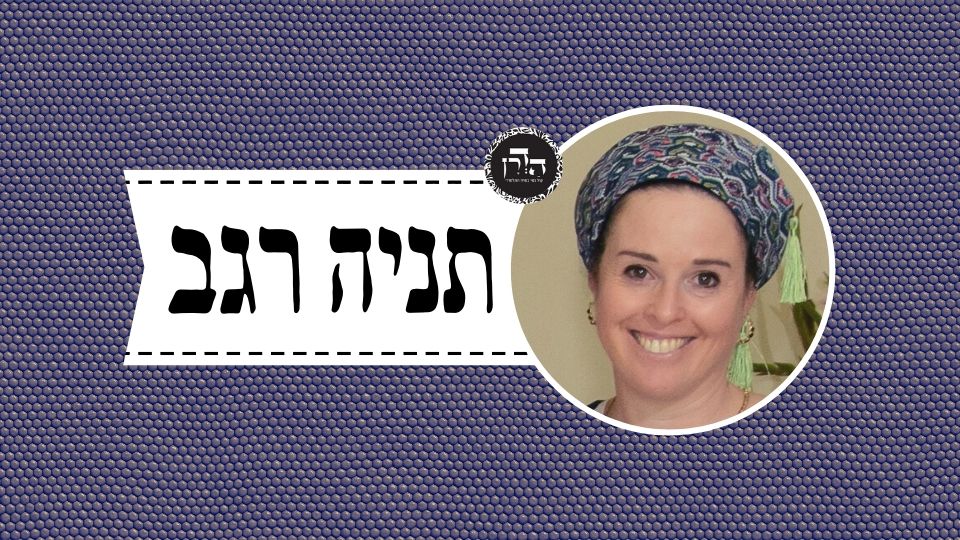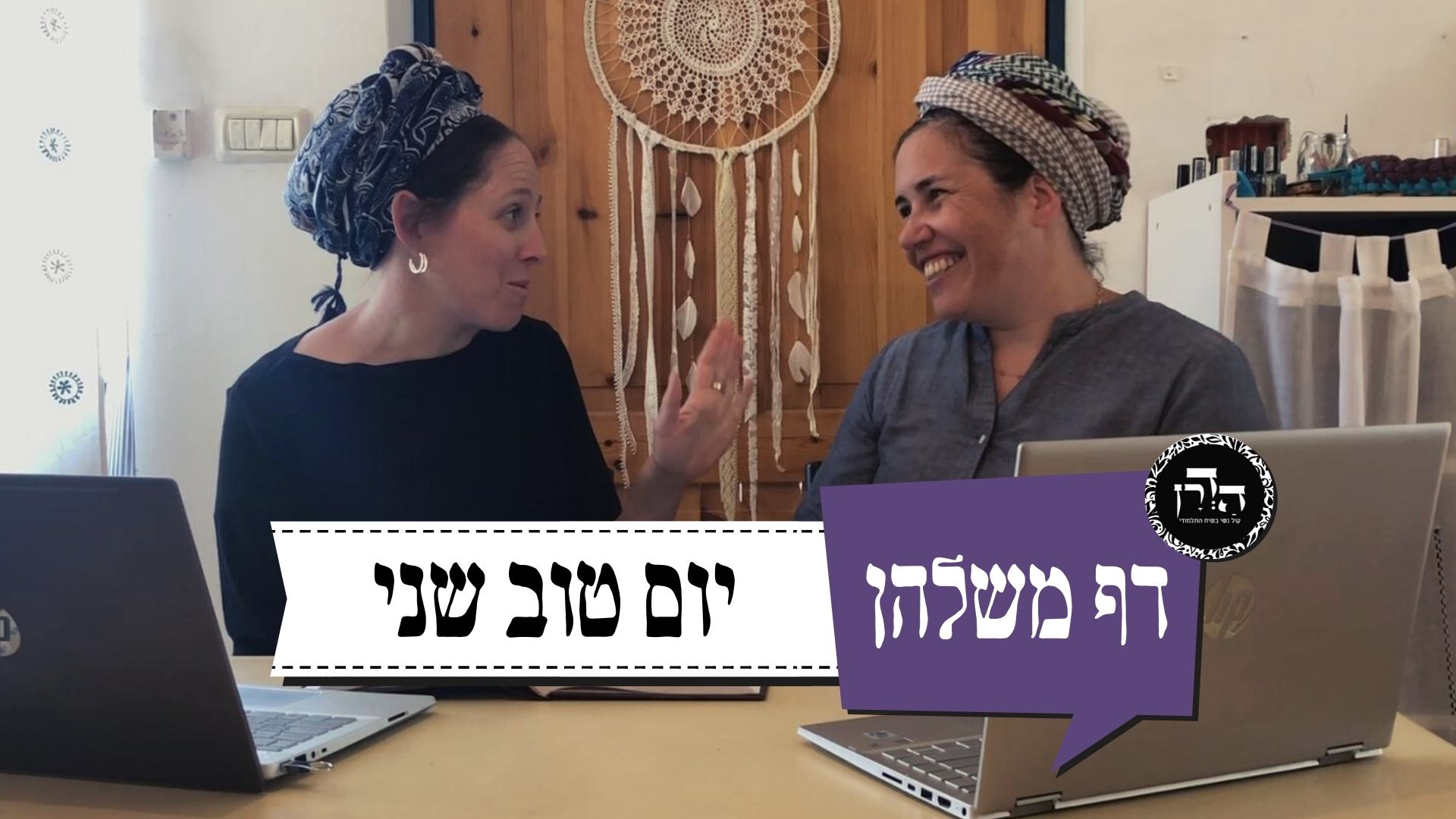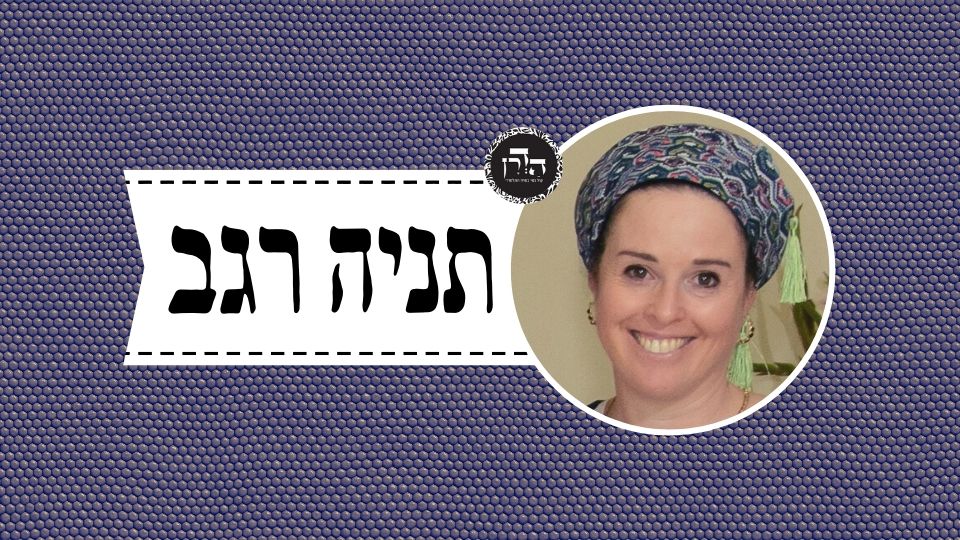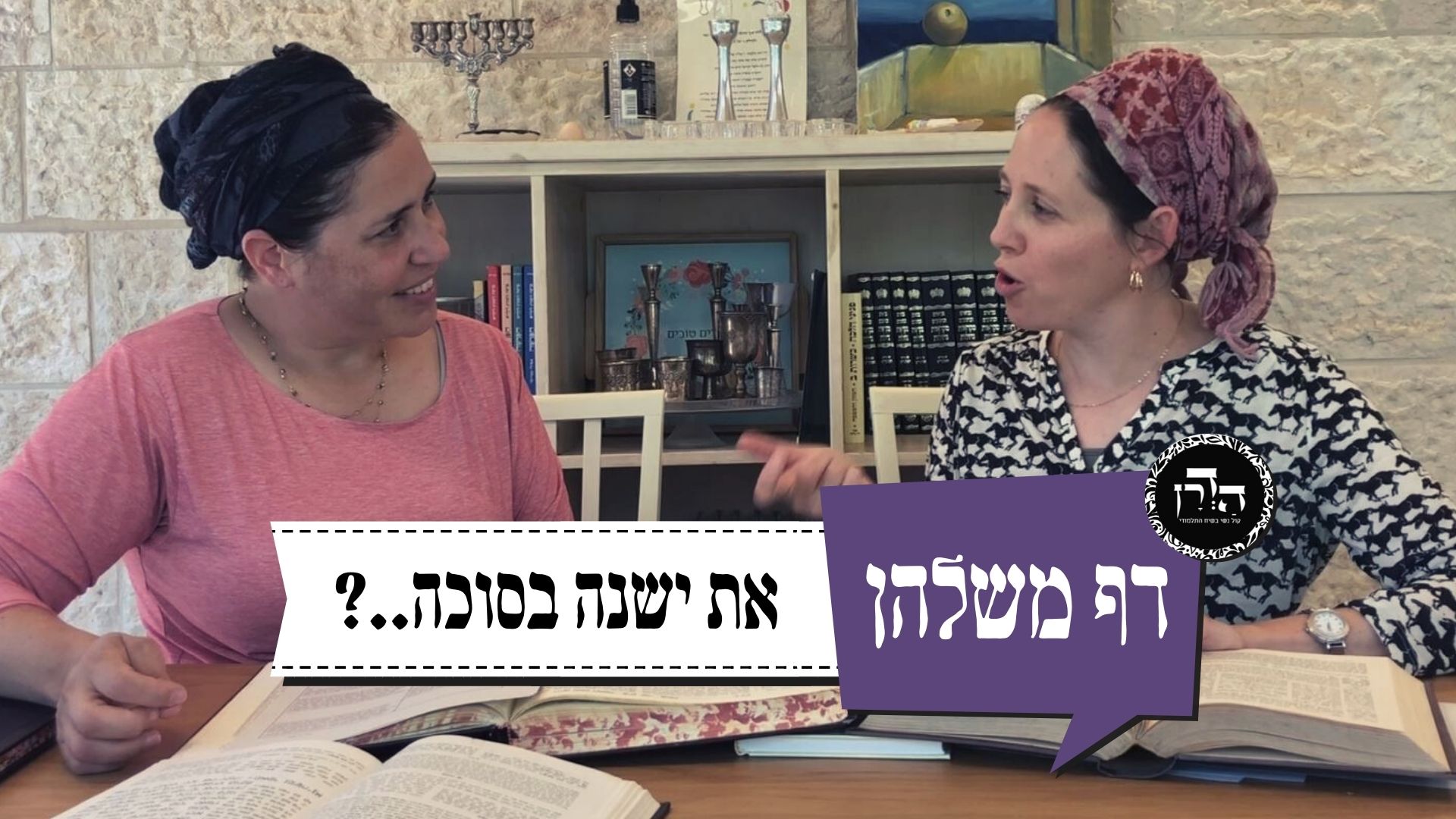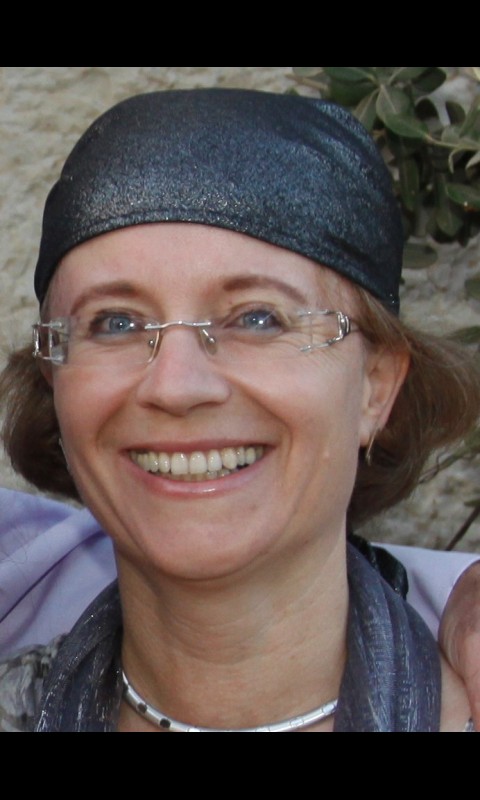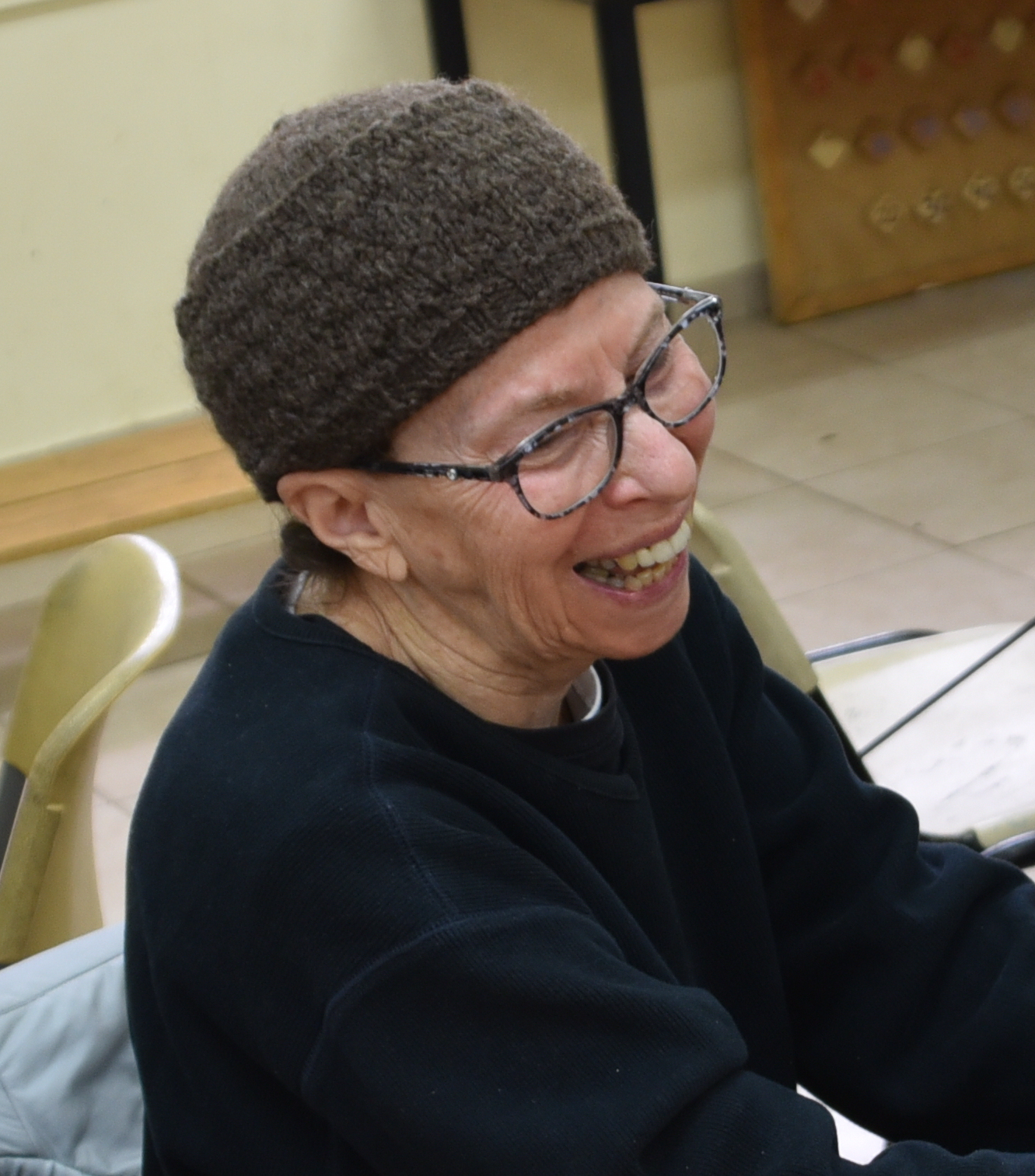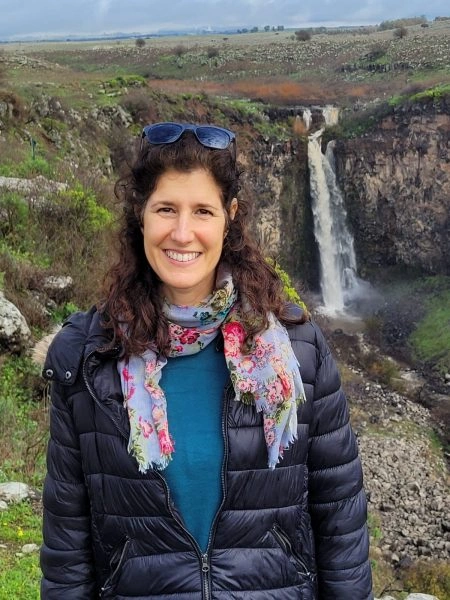סוכה ג
מִשּׁוּם אַוֵּירָא. אֶלָּא לְמַאן דְּאָמַר בְּסוּכָּה קְטַנָּה מַחְלוֹקֶת, וְכִי דַּרְכָּהּ שֶׁל מַלְכָּה לֵישֵׁב בְּסוּכָּה קְטַנָּה? אָמַר רַבָּה בַּר רַב אַדָּא: לֹא נִצְרְכָה אֶלָּא סוּכָּה הָעֲשׂוּיָה קִיטוֹנִיּוֹת קִיטוֹנִיּוֹת.
due to the fresh air that circulates through the openings in the wall. However, according to the one who said that it is specifically in the case of a small sukka that there is a dispute between Rabbi Yehuda and the Rabbis, in which case the baraita is referring to a case where Queen Helene resided in a small sukka, is it customary for a queen to reside in a small sukka whose area is less than four cubits squared? Rabba bar Rav Adda said: This ruling is necessary only in the case of a sukka that is constructed with several small rooms [kitoniyyot]. The sukka was large, but it was subdivided into many small rooms, each of which was smaller than four square cubits.
וְכִי דַּרְכָּהּ שֶׁל מַלְכָּה לֵישֵׁב בְּסוּכָּה הָעֲשׂוּיָה קִיטוֹנִיּוֹת קִיטוֹנִיּוֹת? אָמַר רַב אָשֵׁי: לֹא נִצְרְכָה אֶלָּא לְקִיטוֹנִיּוֹת שֶׁבָּהּ.
Again, the Gemara asks: Is it then customary for a queen to reside in a sukka constructed with several small rooms without leaving a large room in which she could assemble her family and servants? Rav Ashi said: This ruling is necessary only with regard to the compartments in the sukka. It was indeed a large sukka with a large central room; however, there were many small rooms adjacent to the main room. It is with regard to this type of sukka that there is a tannaitic dispute.
רַבָּנַן סָבְרִי: בָּנֶיהָ בְּסוּכָּה מְעַלְּיָא הֲווֹ יָתְבִי, וְאִיהִי יָתְבָה בְּקִיטוֹנִיּוֹת מִשּׁוּם צְנִיעוּתָא, וּמִשּׁוּם הָכִי לָא אָמְרִי לַהּ דָּבָר. וְרַבִּי יְהוּדָה סָבַר: בָּנֶיהָ גַּבָּהּ הֲווֹ יָתְבִי, וַאֲפִילּוּ הָכִי לָא אָמְרִי לַהּ דָּבָר.
The Rabbis hold: Her sons were residing in a full-fledged sukka with a large central room, which everyone agrees was fit. However, she often resided in the small rooms due to modesty, to avoid being in the public eye. And for that reason the Elders did not say anything to her, as even if the small rooms were too small relative to the height of the sukka, there was no problem since her sons did not sit in them. And Rabbi Yehuda holds: Her sons would occasionally reside with her in the small room, and even so, the Elders did not say anything to her, indicating that a sukka more than twenty cubits high is fit even in a small sukka. Now that the Tosefta can be explained according to all the statements cited by the amora’im in the name of Rav, no proof can be cited with regard to the essence of the dispute between Rabbi Yehuda and the Rabbis with regard to a small sukka more than twenty cubits high.
אָמַר רַב שְׁמוּאֵל בַּר יִצְחָק: הֲלָכָה, צְרִיכָה שֶׁתְּהֵא מַחְזֶקֶת רֹאשׁוֹ וְרוּבּוֹ וְשׁוּלְחָנוֹ. אֲמַר לֵיהּ רַבִּי אַבָּא: כְּמַאן, כְּבֵית שַׁמַּאי? אֲמַר לֵיהּ: אֶלָּא כְּמַאן?!
§ Rav Shmuel bar Yitzḥak said: The halakha is that one’s sukka must be large enough to hold his head, and most of his body, and his table. Rabbi Abba said to him, astonished: In accordance with whose opinion did you rule? Was it in accordance with the opinion of Beit Shammai? This is the subject of a dispute between Beit Shammai and Beit Hillel, and according to Beit Hillel it is sufficient for the sukka to be large enough to hold one’s head and most of his body; it need not be large enough to hold his table as well. The halakhic ruling that you issued is in accordance with the opinion of Beit Shammai, despite the fact that in disputes between Beit Shammai and Beit Hillel, the halakha is in accordance with the opinion of Beit Hillel. Rav Shmuel bar Yitzḥak said to him: Rather, in accordance with whose opinion should I rule? Yes, my ruling is in accordance with the opinion of Beit Shammai because in this case that is the halakha.
אִיכָּא דְּאָמְרִי, אָמַר רַבִּי אַבָּא: דַּאֲמַר לָךְ מַנִּי? אֲמַר לֵיהּ: בֵּית שַׁמַּאי הִיא, וְלָא תְּזוּז מִינַּהּ.
Some say that the exchange between the amora’im was slightly different. Rabbi Abba said: Who stated that opinion to you? Rav Shmuel bar Yitzḥak said to him: It was Beit Shammai, and nevertheless do not budge from it, as that is the established halakha. Based on either version of the exchange, there is a dispute between Beit Shammai and Beit Hillel with regard to the minimum measure of a small sukka.
מַתְקֵיף לַהּ רַב נַחְמָן בַּר יִצְחָק: מִמַּאי דְּבֵית שַׁמַּאי וּבֵית הִלֵּל בְּסוּכָּה קְטַנָּה פְּלִיגִי? דִּלְמָא בְּסוּכָּה גְּדוֹלָה פְּלִיגִי, וּכְגוֹן דְּיָתֵיב אַפּוּמָּא דִּמְטוּלְּתָא וְשׁוּלְחָנוֹ בְּתוֹךְ הַבַּיִת. דְּבֵית שַׁמַּאי סָבְרִי: גָּזְרִינַן שֶׁמָּא יִמָּשֵׁךְ אַחַר שׁוּלְחָנוֹ, וּבֵית הִלֵּל סָבְרִי: לָא גָּזְרִינַן.
Rav Naḥman bar Yitzḥak strongly objects to this assumption: From where do you conclude that Beit Shammai and Beit Hillel disagree with regard to the minimum measure of a small sukka? Perhaps it is with regard to a large sukka that they disagree, and in a case where one is sitting at the entrance of the sukka and his table is inside the house. As Beit Shammai hold that we issue a decree to prohibit one from sitting that way lest he be drawn after his table while eating, to the extent that his head and most of his body will be inside the house and not inside the sukka. And Beit Hillel hold that we do not issue that decree.
וְדַיְקָא נָמֵי, דְּקָתָנֵי: מִי שֶׁהָיָה רֹאשׁוֹ וְרוּבּוֹ בַּסּוּכָּה וְשׁוּלְחָנוֹ בְּתוֹךְ הַבַּיִת, בֵּית שַׁמַּאי פּוֹסְלִין וּבֵית הִלֵּל מַכְשִׁירִין. וְאִם אִיתָא, מַחְזֶקֶת וְאֵינָהּ מַחְזֶקֶת מִיבְּעֵי לֵיהּ.
And the language of the mishna is also precise, as it teaches: In the case of one whose head and most of his body were in the sukka and his table was in the house, Beit Shammai deem it unfit and Beit Hillel deem it fit. And if it is so that the dispute is with regard to the minimum measure of the sukka, the formulation of the mishna is missing the essential point. The distinction between a sukka that holds and a sukka that does not hold his head and most of his body is what the mishna needed to say. Since the mishna does not make that distinction, apparently the dispute is not with regard to the minimum measure of a sukka.
וּבְסוּכָּה קְטַנָּה לָא פְּלִיגִי? וְהָתַנְיָא: מַחְזֶקֶת רֹאשׁוֹ וְרוּבּוֹ וְשׁוּלְחָנוֹ — כְּשֵׁרָה. רַבִּי אוֹמֵר: עַד שֶׁיְּהֵא בָּהּ אַרְבַּע אַמּוֹת עַל אַרְבַּע אַמּוֹת.
The Gemara questions this conclusion: And in the case of a small sukka do Beit Shammai and Beit Hillel not disagree? But isn’t it taught in another baraita: A sukka that holds his head, and most of his body, and his table is fit. Rabbi Yehuda HaNasi says: It is unfit until it measures at least four cubits by four cubits.
וְתַנְיָא אִידַּךְ, רַבִּי אוֹמֵר: כׇּל סוּכָּה שֶׁאֵין בָּהּ אַרְבַּע אַמּוֹת עַל אַרְבַּע אַמּוֹת — פְּסוּלָה. וַחֲכָמִים אוֹמְרִים: אֲפִילּוּ אֵינָהּ מַחְזֶקֶת אֶלָּא רֹאשׁוֹ וְרוּבּוֹ — כְּשֵׁרָה. וְאִילּוּ שׁוּלְחָנוֹ לָא קָתָנֵי. קַשְׁיָין אַהֲדָדֵי. אֶלָּא לָאו, שְׁמַע מִינַּהּ: הָא בֵּית שַׁמַּאי, הָא בֵּית הִלֵּל.
And it is taught in yet another baraita that Rabbi Yehuda HaNasi says: Any sukka that does not have an area of at least four cubits by four cubits is unfit. And the Rabbis say: Even if it holds only his head and most of his body, it is fit. However, the term: His table, is not taught in this baraita. If so, these two tannaitic sources contradict each other, as each attributes a different opinion to the Rabbis. Rather, must one not conclude from it that this baraita, in which: His table, is taught, is in accordance with the opinion of Beit Shammai, while that baraita, in which: His table, is not taught, is in accordance with the opinion of Beit Hillel? Apparently, they do dispute the minimum measure of a small sukka.
אָמַר מָר זוּטְרָא: מַתְנִיתִין נָמֵי דַּיְקָא, מִדְּקָתָנֵי: ״בֵּית שַׁמַּאי פּוֹסְלִין, וּבֵית הִלֵּל מַכְשִׁירִין״, וְאִם אִיתָא, ״בֵּית שַׁמַּאי אוֹמְרִים לֹא יָצָא, וּבֵית הִלֵּל אוֹמְרִים יָצָא״ מִיבְּעֵי לֵיהּ.
Mar Zutra said: And the language of the mishna is also precise, and it indicates that Beit Shammai and Beit Hillel indeed dispute the minimum measure of a small sukka from the fact that it teaches: Beit Shammai deem it unfit and Beit Hillel deem it fit. And if it is so that the dispute is with regard to the conduct of one sitting at the entrance of a large sukka, then Beit Shammai say: He did not fulfill his obligation, and Beit Hillel say: He fulfilled his obligation, is what the mishna needed to say. However, the terms fit and unfit indicate that the dispute is with regard to the halakhic status of the sukka itself, not the individual’s behavior.
וְאֶלָּא קַשְׁיָא ״מִי שֶׁהָיָה״!
The Gemara asks: But if that is so, the formulation of the mishna: One whose head and most of his body were in the sukka, is difficult, as it indicates that the dispute is with regard to where in the sukka he was sitting. The mishna does not say: A sukka that holds his head and most of his body, which would indicate that the dispute is with regard to the minimum measure of the sukka.
לְעוֹלָם בְּתַרְתֵּי פְּלִיגִי: פְּלִיגִי בְּסוּכָּה קְטַנָּה, וּפְלִיגִי בְּסוּכָּה גְּדוֹלָה. וְחַסּוֹרֵי מִיחַסְּרָא וְהָכִי קָתָנֵי: מִי שֶׁהָיָה רֹאשׁוֹ וְרוּבּוֹ בַּסּוּכָּה וְשׁוּלְחָנוֹ בְּתוֹךְ הַבַּיִת, בֵּית שַׁמַּאי אוֹמְרִים: לֹא יָצָא, וּבֵית הִלֵּל אוֹמְרִים: יָצָא. וְשֶׁאֵינָהּ מַחְזֶקֶת אֶלָּא כְּדֵי רֹאשׁוֹ וְרוּבּוֹ בִּלְבַד, בֵּית שַׁמַּאי פּוֹסְלִין, וּבֵית הִלֵּל מַכְשִׁירִין.
The Gemara answers: Actually, they disagree with regard to two issues; they disagree with regard to the minimum measure of a small sukka, and they disagree with regard to where one may sit in a large sukka. And the mishna is incomplete and this is what it is teaching: One whose head and most of his body were in the sukka and his table was in the house, Beit Shammai say that he did not fulfill his obligation and Beit Hillel say that he fulfilled his obligation. And with regard to a sukka that holds only his head and most of his body, Beit Shammai deem it unfit and Beit Hillel deem it fit. In this way, the dispute in the mishna is understood as relating to the measure of a small sukka and the manner in which one fulfills his obligation in a large sukka.
מַאן תְּנָא לְהָא דְּתָנוּ רַבָּנַן: בַּיִת שֶׁאֵין בּוֹ אַרְבַּע אַמּוֹת עַל אַרְבַּע אַמּוֹת — פָּטוּר מִן הַמְּזוּזָה, וּמִן הַמַּעֲקֶה, וְאֵינוֹ מִטַּמֵּא בִּנְגָעִים, וְאֵינוֹ נֶחְלָט בְּבָתֵּי עָרֵי חוֹמָה,
§ Apropos the above discussion, the Gemara asks: Who is the tanna who taught that which the Sages taught: The halakhic status of a house in which there is not an area of four cubits by four cubits is not that of a house? Therefore, halakhot in the Torah or the mishna that are relevant to a house do not apply to a house that size. Consequently, it is exempt from the mitzva of placing a mezuza on its doorpost; and it is exempt from the obligation of establishing a parapet around its roof; and it does not become ritually impure with leprosy of the house. And its sale is not rendered final in the same manner as the sale of houses within walled cities. The owner of a house in a walled city who sells his house has the option to buy it back from the purchaser within one year of the sale. If he fails to do so, the sale is rendered final and the house does not return to the original owner during the Jubilee Year (see Leviticus 25:29–31).
וְאֵין חוֹזְרִין עָלָיו מֵעוֹרְכֵי הַמִּלְחָמָה, וְאֵין מְעָרְבִין בּוֹ, וְאֵין מִשְׁתַּתְּפִין בּוֹ, וְאֵין מַנִּיחִין בּוֹ עֵירוּב,
And one does not return from the ranks of soldiers waging war for a house that size, as would one who built a house with an area greater than four by four cubits (see Deuteronomy 20:5). And one need not join the houses in the courtyards for a house with that area. If there is more than one house in a courtyard, it is prohibited by rabbinic law to carry in that courtyard unless the residents of each of the houses contribute food that is placed in one of the houses, thereby rendering them joint-owners of the courtyard. The resident of a house with an area of less than four by four cubits need not participate in this joining of courtyards. And one need not merge the courtyards that open into an alleyway for a courtyard in which the area of its only house is less than four by four cubits. In this case, too, the resident of that courtyard need not participate in the merging of alleyways. And one does not place the food collected for the aforementioned joining [eiruv] of courtyards in this house but rather in a house with an area of at least four by four cubits.
וְאֵין עוֹשִׂין אוֹתוֹ עִיבּוּר בֵּין שְׁתֵּי עֲיָירוֹת, וְאֵין הָאַחִין וְהַשּׁוּתָּפִין חוֹלְקִין בּוֹ.
And one does not render it an extension of the city limits when it is located between two cities. Two cities between which there is a distance of more than 141⅓ cubits cannot be joined and considered as a single city for the purpose of measuring the Shabbat limit for one city from the edge of the second city. However if there is a house equidistant between the two cities, i.e., a bit more than seventy cubits from each town, the house joins the two cities together for the purpose of measuring the Shabbat limit. A house in which there is an area of less than four by four cubits cannot serve this function; and brothers and partners do not divide it, as it is too small to be divided.
לֵימָא רַבִּי הִיא וְלָא רַבָּנַן? אֲפִילּוּ תֵּימָא רַבָּנַן, עַד כָּאן לָא קָאָמְרִי רַבָּנַן הָתָם אֶלָּא לְעִנְיַן סוּכָּה — דְּדִירַת עֲרַאי הִיא, אֲבָל לְגַבַּי בַּיִת — דְּדִירַת קֶבַע הוּא, אֲפִילּוּ רַבָּנַן מוֹדוּ דְּאִי אִית בֵּיהּ אַרְבַּע אַמּוֹת עַל אַרְבַּע אַמּוֹת — דָּיְירִי בֵּיהּ אִינָשֵׁי, וְאִי לָא — לָא דָּיְירִי בֵּיהּ אִינָשֵׁי.
In answer to the question with regard to the identity of the tanna of the baraita, the Gemara says: Let us say that the tanna of the baraita is Rabbi Yehuda HaNasi and not the Rabbis, as it is Rabbi Yehuda HaNasi who holds that a sukka with an area of less than four by four cubits is unfit. The Gemara rejects this contention: Even if you say that the tanna of the baraita is the Rabbis, the Rabbis say that a structure with an area smaller than four by four cubits is fit only there, with regard to a sukka, which is a temporary residence, because in a temporary residence one is willing to confine himself to a small area. However, with regard to halakhot relating to a house, which is a permanent residence, even the Rabbis concede that if it has an area of four cubits by four cubits, people reside in it, as it is a functional house, and if not, people do not reside in it, and its legal status is not that of a house at all.
אָמַר מָר: פָּטוּר מִן הַמְּזוּזָה, וּמִן הַמַּעֲקֶה, וְאֵין מִטַּמֵּא בִּנְגָעִים, וְאֵינוֹ נֶחְלָט בְּבָתֵּי עָרֵי חוֹמָה, וְאֵין חוֹזְרִין עָלָיו מֵעוֹרְכֵי הַמִּלְחָמָה. מַאי טַעְמָא? דְּ״בַיִת״ כְּתִיב בְּהוּ בְּכוּלְּהוּ.
§ The Gemara briefly discusses the halakhot listed in the baraita: The Master said that a house in which there is an area of less than four by four cubits it is exempt from the mitzva of placing a mezuza on its doorpost, and it is exempt from the obligation of establishing a parapet around its roof, and it does not become ritually impure with leprosy of the house. And its sale is not rendered final in the same manner as the sale of houses within walled cities, and one does not return from the ranks of soldiers waging war for a house that size. What is the reason for these halakhot? It is due to the fact that “house” is written in the Torah with regard to all these halakhot. The legal status of a structure with an area of less than four by four cubits is not that of a house.
וְאֵין מְעָרְבִין בּוֹ, וְאֵין מִשְׁתַּתְּפִין בּוֹ, וְאֵין מַנִּיחִין בּוֹ עֵירוּב. מַאי טַעְמָא — דְּלָא חֲזֵי לְדִירָה. עֵירוּבֵי חֲצֵירוֹת — אֵין מַנִּיחִין בּוֹ, אֲבָל שִׁיתּוּף מַנִּיחִין בּוֹ.
And by rabbinic law, one need not join the houses in the courtyards for a house with that area, and one need not merge the courtyards that open into an alleyway for a courtyard in which the area of its only house is less than four by four cubits. And one does not place the food collected for the joining of courtyards in this house. What is the reason for these halakhot? It is due to the fact that it is not fit for residence. The point of the joining of courtyards is to transform the courtyard into a residence shared by the residents of all its member households, and this can be accomplished only by placing the joint food in a place whose legal status is that of a house. The Gemara infers this from the fact that it is taught in the baraita: And one does not place the food of the joining of courtyards in this house, but the food of the merging of alleyways, one places in it.
מַאי טַעְמָא — דְּלָא גָּרַע מֵחָצֵר שֶׁבְּמָבוֹי. דִּתְנַן: עֵירוּבֵי חֲצֵירוֹת בֶּחָצֵר, שִׁיתּוּפֵי מָבוֹי בַּמָּבוֹי.
What is the reason for this distinction? It is due to the fact that it is no less a residence than a courtyard in the alleyway. An unroofed courtyard is not fit for residence, and nevertheless the food for the merging of alleyways may be placed there, as we learned in a baraita in tractate Eiruvin (85b): The joining of courtyards may be placed in the courtyard and the merging of alleyways may be placed in the alleyway.
וְהָוֵינַן בַּהּ, עֵירוּבֵי חֲצֵירוֹת בֶּחָצֵר? וְהָתְנַן: הַנּוֹתֵן עֵירוּבוֹ בְּבֵית שַׁעַר אַכְסַדְרָה וּמִרְפֶּסֶת — אֵינוֹ עֵירוּב, וְהַדָּר שָׁם אֵינוֹ אוֹסֵר.
And we discussed this halakha: How can the joining of courtyards be placed in the courtyard? Didn’t we learn in the mishna: With regard to one who placed his joining of courtyards in a gatehouse or in a portico [akhsadra], a roofed structure without walls or with incomplete walls, or on a balcony, it is not a fit eiruv. And one who resides there, in any of these structures, does not render it prohibited for the homeowner and the other residents of the courtyard to carry, even if he did not contribute to the eiruv, as the legal status of these places is not that of a house.
אֶלָּא אֵימָא: עֵירוּבֵי חֲצֵירוֹת בְּבַיִת שֶׁבֶּחָצֵר, וְשִׁיתּוּפֵי מְבוֹאוֹת בְּחָצֵר שֶׁבַּמָּבוֹי. וְהַאי לָא גָּרַע מֵחָצֵר שֶׁבְּמָבוֹי.
Rather, emend the mishna and say: The joining of courtyards is placed in one of the full-fledged houses that is in the courtyard, and the merging of alleyways is placed even in one of the courtyards that opens into the alleyway. And this house whose area is less than four by four cubits is no less a residence than one of the courtyards that open into the alleyway.
וְאֵין עוֹשִׂין אוֹתוֹ עִיבּוּר בֵּין שְׁתֵּי עֲיָירוֹת. דַּאֲפִילּוּ כְּבוּרְגָּנִין לָא מְשַׁוֵּינַן לֵיהּ. מַאי טַעְמָא — בּוּרְגָּנִין חֲזוּ לְמִילְּתַיְיהוּ, וְהַאי לָא חֲזֵי לְמִילְּתֵיהּ.
It is taught in the baraita: And one does not render it an extension of the city limits when it is located between two cities. The Gemara explains: This means that we do not even render its halakhic status like that of huts [burganin] used by grain watchmen in the fields, which join the two cities between which they are located for the purpose of measuring the Shabbat limit. What is the reason that it is considered less a residence than a watchman’s hut? The Gemara answers: Watchmen’s huts, even though they are not sturdy, are suited for their matters, while this house with an area less than four by four cubits is not suited for its matter, as it is not fit for residence.
וְאֵין הָאַחִין וְהַשּׁוּתָּפִין חוֹלְקִין בּוֹ. טַעְמָא דְּלֵית בֵּיהּ אַרְבַּע אַמּוֹת, הָא אִית בֵּיהּ אַרְבַּע אַמּוֹת — חוֹלְקִין,
It is taught in the baraita: And brothers and partners do not divide a house that does not measure at least four by four cubits, as it is too small to be divided. The Gemara infers: The reason that a house that size is not divided is due to the fact that there is not an area of four by four cubits in it; however, if there is an area of four by four cubits in it, they divide it.
וְהָתְנַן: אֵין חוֹלְקִין אֶת הֶחָצֵר עַד שֶׁיְּהֵא בָּהּ אַרְבַּע אַמּוֹת לָזֶה וְאַרְבַּע אַמּוֹת לָזֶה!
The Gemara asks: But didn’t we learn in a mishna: One divides the courtyard at the request of one of the heirs or partners only if its area is sufficient so that there will be in it four by four cubits for this partner or heir and four by four cubits for that partner or heir? Apparently, in order to divide a courtyard it must be at least four by eight cubits.
אֶלָּא אֵימָא: אֵין בּוֹ דִּין חֲלוּקָּה כְּחָצֵר. דְּאָמַר רַב הוּנָא: חָצֵר לְפִי פְּתָחֶיהָ מִתְחַלֶּקֶת. וְרַב חִסְדָּא אָמַר: נוֹתֵן לְכׇל פֶּתַח וָפֶתַח אַרְבַּע אַמּוֹת, וְהַשְּׁאָר חוֹלְקִין אוֹתוֹ בְּשָׁוֶה.
Rather, emend the baraita and say that the halakha of division like that of a courtyard does not apply to it. As Rav Huna said: A courtyard is divided according to the number of its entrances. When the residents of the houses in a courtyard divide the courtyard between them, the division is not based on the number of houses in the courtyard, nor is it based on the size of the houses. Instead, it is divided based on the number of entrances that open into the courtyard. Rav Ḥisda said: One gives the homeowner for each and every entrance four cubits, and the rest of the courtyard is divided equally among the residents of the courtyard.
דְּהָנֵי מִילֵּי בַּיִת, דִּלְמֶהֱוֵי קָאֵי — יָהֲבִינַן לֵיהּ חָצֵר. הַאי, דִּלְמִיסְתַּר קָאֵי — לָא יָהֲבִינַן לֵיהּ חָצֵר.
The principle that entrances are factored into the division of a courtyard applies only with regard to a house that stands to endure, as the owner needs use of the yard to ease access to his house, so we provide him with four cubits according to Rav Ḥisda, or part of the courtyard according to Rav Huna. However, in the case of this small house, which stands to be leveled, its owner has no need for the adjacent courtyard, so we do not provide him with any part of the courtyard, as if it were not even there.
הָיְתָה גְּבוֹהָה מֵעֶשְׂרִים אַמָּה וּבָא לְמַעֲטָהּ בְּכָרִים וּכְסָתוֹת — לָא הָוֵי מִיעוּט.
§ With regard to the halakha in the mishna that a sukka more than twenty cubits high is unfit, the Gemara states: If the sukka was more than twenty cubits high and one comes to diminish its height by placing cushions and blankets on the floor, it is not a decrease of halakhic significance. It does not render the sukka fit, because in that case one is concerned that the bedding will be ruined and therefore does not intend to leave it there very long.


